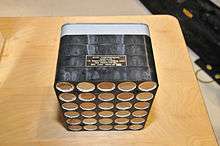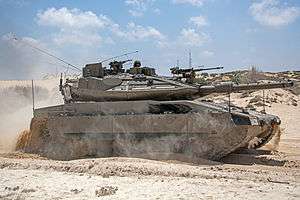Active protection system
An active protection system is a system (usually for a military application) designed to prevent line-of-sight guided anti-tank missiles/projectiles from acquiring and/or destroying a target.
Electronic countermeasures that alter the electromagnetic, acoustic or other signature(s) of a target thereby altering the tracking and sensing behavior of an incoming threat (e.g., guided missile) are designated soft-kill measures.
Measures that physically counterattack an incoming threat thereby destroying/altering its payload/warhead in such a way that the intended effect on the target is severely impeded are designated hard-kill measures.
Soft-kill measures
Soft-kill measures are applied when it is expected that a sensor-based weapon system can be successfully interfered with. The threat sensor can be either an artificial one, e.g., a solid-state infrared detector, or the human sensory system (eye and/or ear).
Soft-kill measures generally interfere with the signature of the target to be protected. In the following the term signature refers to the electromagnetic or acoustic signature of an object in either the ultraviolet (wavelength: 0.3–0.4 μm), visual (0.4–0.8 μm), or infrared (0.8 - 14 μm) spectral range as well as cm-radar range (frequency: 2–18 GHz), mmw-radar (35, 94, 144 GHz) and finally sonar range (either 50 Hz – 3 kHz and/or 3–15 kHz).
One or more of the following actions may be taken to provide soft-kill:
- Reduction of signature
- Augmentation of signature
Soft-kill countermeasures can be divided into on-board and expendable countermeasures. Whereas on-board measures are fixed on the platform to be protected, expendable measures are ejected from the platform.
Preemptive action of countermeasures is directed to generally prevent lock-on of a threat sensor to a certain target. It is based on altering the signature of the target by either concealing the platform signature or enhancing the signature of the background, thus minimizing the contrast between the two.
Reactive action of countermeasures is directed toward break-lock of a threat already homing in on a certain target. It is based on the tactics of signature imitation, augmentation, or reduction.
Aerial countermeasures

Generally one has to distinguish between infrared and radar countermeasures. The wavelength range between 0.8 and 5 μm is considered as Infrared (IR), the frequency range between 2 and 18 GHz is considered as Radar.

In the wake of shoulder-launched missile attacks against civilian passenger and cargo airliners in the early 2000s, various agencies investigated the feasibility of equipping countermeasures such as chaff and flares. Many commercial carriers found the estimated price of countermeasures to be too costly. However, the Israeli airline El-Al, having been the target of the failed 2002 airliner attack, in which shoulder-launched surface-to-air missiles were fired at an airliner while taking off, began equipping its fleet with radar-based, automated flare release countermeasures from June 2004.[1] This caused concerns in some European countries, regarding the possible fire hazard at civilian airports, resulting in banning such aircraft from landing at their airports.[2] In 2007, Saab announced a new infrared countermeasure system called CAMPS that does not use pyrotechnic flares, thereby directly addressing these concerns.
IR-decoy flares
.jpg)
IR-decoy flares serve to counter infrared-guided surface-to-air missiles (SAM) or air-to-air missiles (AAM) and can be expelled from a craft according to an anticipated threat in defined sequences.
Radar decoys
To counter radar-guided missiles, chaff is used. These are copper nickel-coated glass fibers or silver-coated nylon fibers having lengths equal to half of the anticipated radar wavelength.
New systems, such as the BriteCloud expendable active decoy, use DRFM technology to generate a false target, luring the RF threat system away from the aircraft.[3]
Naval decoys
Land and sea-based forces can also use such countermeasures, as well as smoke-screens that can disrupt laser ranging, infrared detection, laser weapons, and visual observation.
Hard-kill measures
Except for countering intercontinental ballistic missiles, hard-kill measures generally refer to measures taken in the so-called "end-game" shortly before a warhead/missile hits its target. The hard-kill measure in general physically affects the incoming warhead/missile by means of either blast and/or fragment action. The action may lead to:
- disturbance of the stability of a kinetic energy penetrator which will decrease its penetration ability as the deflection angle increases.
- premature initiation of a shaped charge (e.g., too great stand-off), but most likely improper initiation, thereby impeding optimum jet development of the metallic lining, usually copper, in the shaped charge. The copper jet provides most of the anti armor capabilities of shaped charge weapons.
- destruction of the airframe of an inbound missile or shell.
There are many examples of active countermeasures. For example, the Russian-made Arena system utilizes a Doppler radar to detect incoming threats and fires a top attack rocket to eliminate the threat. The Israeli Trophy system fires a shotgun-like blast to destroy the threat. An American system known as Quick Kill detects incoming threats using an Active Electronically Scanned Array, which assesses the threat, and deploys a smaller rocket countermeasure. Another American system, known as Iron Curtain, utilizes two sensors to reduce false alarms and defeat threats inches from their target by firing a kinetic countermeasure designed to minimize collateral damage.
The Russian T-14 Armata tank features the Afghanit (Russian: Афганит) active protection system (APS),[4] which includes a millimeter-wavelength radar to detect, track, and intercept incoming anti-tank munitions, both kinetic energy penetrators (reportedly) and tandem-charges.[5][6] Currently, the maximum speed of the interceptable target is 1,700 m/s (Mach 5.0), with projected future increases of up to 3,000 m/s (Mach 8.8).[7] According to news sources, it protects the tank from all sides.[8][9]
Reactive armor
An example of a hard-kill countermeasure is the reactive armor, a sandwich of high explosive material between two armor plates found on many modern armored vehicles. As a penetrator hits the armor, the explosive detonates, which disrupts any plasma jet generated by the penetrator, damaging it.[10]
Anti-aircraft weapons
Another example of hard-kill countermeasures is the use of short-range missiles or rapid-fire guns to protect warships and fixed installations from cruise missile, bomb and artillery attacks.
Anti-ballistic missiles
Countermeasures are a complicating factor in the development of anti-ballistic missile defense systems targeting ICBMs. Like aircraft, ICBMs theoretically could evade such systems by deploying decoys and chaff in the midcourse phase of flight. Novel proposed chaff mechanisms describe the creation of a "threat cloud" by deploying large aluminized PET film balloons which could conceal a warhead among a large number of inert objects having similar radar profiles.
Potential performance problems
Clutter
Mountains and neighboring vehicles reflect radio waves, thus creating radar clutter, which adversely affects radar-detection and radar-lock performance.
Top attack munitions
Top attack ATGMs like the FGM-148 Javelin (US) and Trigat (Germany) attack the tank turret's top, requiring the active protection system to attack nearly vertically, for which turret might have not been designed. The same is true for an RPG being fired in a steep downward angle from an elevated location at a target below.
See also
- Anti-aircraft
- Anti-ballistic missile
- Close-in weapon system
- Digital Radio Frequency Memory
- Electronic countermeasures
- Flare (countermeasure)
- Infrared countermeasures
- National Missile Defense
- Strategic Defense Initiative
- Sentry gun
Examples of active protection systems (country of origin)
- Akkor Active Protection System (Turkey)
- GL5 Active Protection System (China)
- AMAP-ADS Active Protection System (Germany)
- Arena active protection system (Russia)
- Drozd active protection system (Russia)
- Iron Curtain active protection system (United States)
- Iron Fist active protection system (Israel)
- LEDS active protection system (Sweden/South Africa)
- Quick Kill active protection system (United States)
- Trophy active protection system (Israel)
- Zaslon Active Protection System (Ukraine)
- Sarab Active Protection System (Syria)
References
- John Vause, "Missile defense for El Al fleet", CNN, May 24, 2004. Accessed July 18, 2006.
- Eldad Beck, "Europe objects to El Al's anti-missile shield", Ynetnews, Feb 26, 2006. Accessed July 18, 2006.
- "Selex ES lancia il BriteCloud Expendable Active Decoy, la nuova contromisura selezionata da Saab per il Gripen - DETTAGLIO - Leonardo - Aerospace, Defence and Security".
- Sputnik. "Can't Touch This! Russian Armata Tanks to Get New Active Protection System". sputniknews.com. Retrieved 2017-09-04.
- "Танк Т-14 "Армата" или Т-99 "Приоритет"" [Tank T-14 "Armata" or T-99 "priority"] (in Russian). vpk.name. Retrieved 6 May 2015.
- "Archived copy" (PDF). Archived from the original (PDF) on 2015-05-18. Retrieved 2017-03-26.CS1 maint: archived copy as title (link)
- tvzvezda.ru, Редакция. "«Армата» против «Леопарда»: новый русский танк превзойдет все мировые аналоги". tvzvezda.ru (in Russian). Retrieved 2017-09-04.
- Птичкин, Сергей (5 May 2015). "Ракеты собьют на подлете". Rossiyskaya Gazeta (in Russian). Retrieved 13 May 2015.
- Administrator. "T-14 Armata Russian main battle tank technical data sheet specifications information description pictures | Russia Russian army tank heavy armoured vehicles U | Russia Russian army military equipment vehicles UK". www.armyrecognition.com. Retrieved 2017-09-04.
- Andrew Feickert, Congressional Research Service R45519 "The Army’s Optionally Manned Fighting Vehicle (OMFV) Program: Background and Issues for Congress, Updated October 10, 2019 note 13
External links
- Access on Jan 11, 2011. Active Protective Systems: Impregnable Armor or Simply Enhanced Survivability? — An overview of modern tank active protection systems (PDF)
- Active Protective Systems overview - Defense Update
- Soft Kill Active Protective Systems overview - Defense Update
